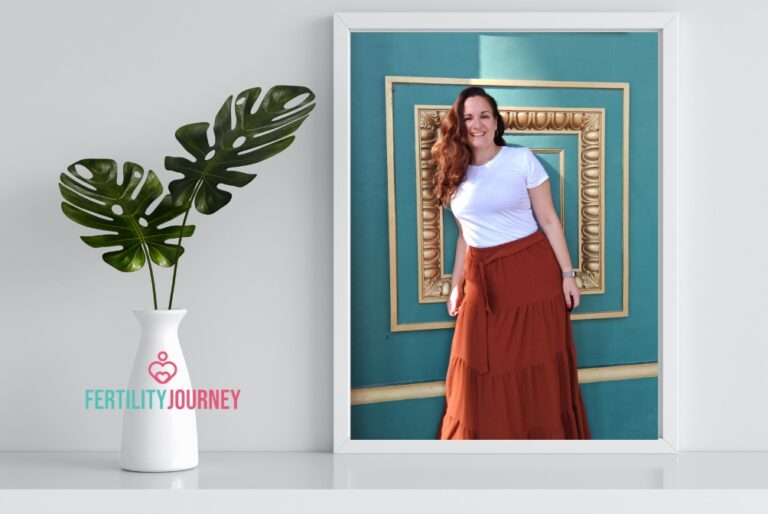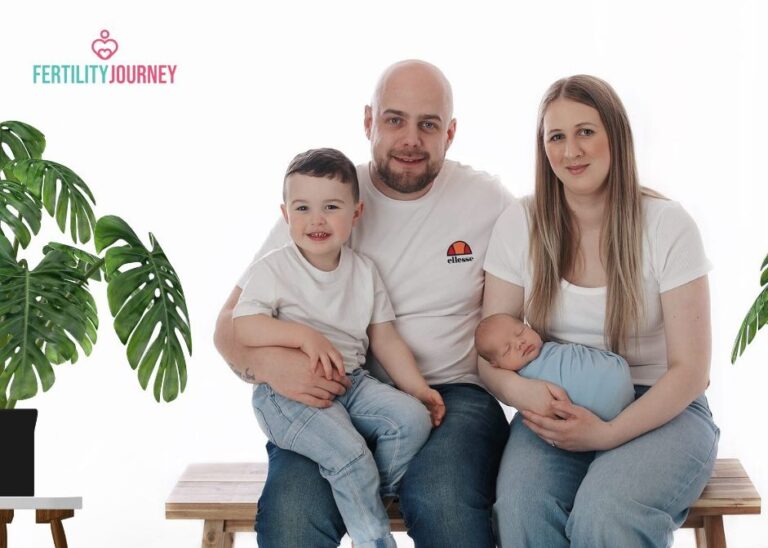Here we are – THE END… of the journey – oh no, this is the end of the chapter “The journey that led us to the best souvenir ever – baby Luna”.
Stacey & Kurt were successful with their application for a free IVF cycle with our Spanish clinic partner University Hospital Quironsalud Madrid last year.
NEW GORGEOUS BEGINNING for Stacey and Kurt – Luna
55 minutes to midnight, the midwife prepared a name tag and she said that she would gamble and wrote 1st of Feb and Luna was born a couple of minutes after midnight 🙂 The joy, love, happiness… well there is no room for any other feeling… I guess it is hard for Luna to breathe with air being stuffed with those emotions 😉
The last time we checked in with the couple they were right before their 32 week scan and you might think that the journey to this point took 9 months/40 weeks more or less, and those who know a bit more about IVF can think that it took an additional a couple of months so perhaps a year in total. The truth is it took two of them to complete the little precious dream over 3 years.

How did the couple reach this point?
Time for retrospection of FERTILITY JOURNEY.
By the book or let’s precise – “by the guidelines”, Stacey and Kurt reached out for help after 12 months of trying and not succeeding in achieving pregnancy. The investigation led to a diagnosis of PCOS. This is something that Stacey suspected as there were “typical” symptoms and she visited a doctor previously to confirm it…but even the RED FLAGS were there… there had been no final confirmation.
Stacey was for the following 6 months on hormonal medication with the aim to help her ovulate. After this period of time, with no pregnancy, the couple was referred for an IVF procedure. The first and only stimulation led to one embryo which was transferred and no pregnancy occurred.
Let us pause here as we are reaching another milestone in Stacey and Kurt’s “Fertility Journey”
We have here described steps that the couple took to reach that point. No emotions, no hopes – no feelings – just the steps. Stacey and Kurt were very supportive of each other, they were open towards family and friends on how the process looked like. The turning point was not the negative pregnancy test after the first IVF treatment but the way it was communicated by the NHS staff (!)
That was the moment that Stacey said “I will not do it again”.
“Communication is a key” – we heard that way too often…to the point that we had forgotten that not only it is essential the message itself but the way you present it – adapt the message to whom you present it and what possible impact it may have with the way you do it. What the staff did – from outside, frankly, nothing wrong – simply stated what the situation is, presented options and…hang up.
What it looked like from Stacey’s perspective…
”Okay, so it didn’t work, here is a number for the counsellor to get support. You will be on a waiting list and most likely you will be over the grieving process by the time it will be your appointment…”
Why did I almost not proceed with another IVF?
Could anybody be blamed for quitting the dream at that point? We can understand that there are policies and rigid pathways when proceeding with treatment on the NHS. There is no room for tailored treatment – one way applies to all. We possibly could not blame a particular doctor, hospital or clinic for following rules set by the NHS but can we expect to be more sensitive in such intimate areas like fertility?
Treatment abroad – fears, challenges and a couple of pounds of cute outcome
Luckily, even with all the horror after failed treatment back home, the solution came with Stacey’s sister’s advice who was herself a winner of treatment abroad (just to add a successful one 🙂
The couple applied and were selected by Quiron Salud and proceeded with treatment in Madrid.
There was also another change in the couple’s way of proceeding with the treatment, not only location – they kept it secret. A handful number of people knew that they were having another treatment…not to mention that it was abroad. This decision had an impact on the “support system” and coping mechanisms as only Kurt was there to handle “the rollercoaster” of emotions.
The first striking difference – communication. Marta, the coordinator, did all the follow-ups, answered all the questions and helped solve any doubts. She was prompted with messages and made an effort to make them feel taken care of.
Tests, check-up – more detailed ones.
Language barrier – there is an option of nonverbal communication if there is a will of course. Stacey described the moment of egg retrieval when she was with a Spanish-speaking nurse…she smiled, rubbed her head, and without a single English word made her calm and sure that she is in good hands.
Language barrier was made up by kindness
Treatment – the doctor presented options. Knowing that Stacey might respond to stimulating medication more than expected because of her PCO, advised that there might be no fresh transfer as in her best interest would be to proceed with transfer on natural cycle. There were 6 embryos ready and yet, the doctor did not want to risk losing a single one and gave the best option.
Care – it might seem silly but staff picked them up from the airport, dropped off at the hotel and later on picked them up from the hotel and transported them to the clinic. That logistic part was completely taken off their shoulders.
Challenges – yes, there was one – prescriptions written in Spanish. That’s the only obstacle a couple could think of in regards to their treatment in Spain.
We need to remember that treatment was not in regular circumstances – there was pandemia, lock-ups, cancelled flights… stress for regular people.
Back to the UK
We spoke about NHS procedures perhaps not in good light so let us be fair and add purely positive one. After the pregnancy was confirmed, there was a person designated to follow up with her as the pregnancies resulting from IVF are considered “higher risk”, there are more scans (12, 16, 24, 32 week) and calls to monitor health.
Our plans
There are 5 embryos in Quiron Salud left and Stacey is sure that Luna will have siblings :)))



